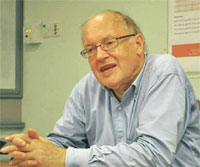 For this article, we sought the expertise of Professor Andrew Palmer, who is currently a professor of Civil Engineering at the National University of Singapore. He is a Fellow of the Royal Society, the Royal Academy of Engineering and the Institution of Civil Engineers, as well as a Chartered Engineer specializing in marine pipelines, offshore engineering, geotechnics, and ice.
For this article, we sought the expertise of Professor Andrew Palmer, who is currently a professor of Civil Engineering at the National University of Singapore. He is a Fellow of the Royal Society, the Royal Academy of Engineering and the Institution of Civil Engineers, as well as a Chartered Engineer specializing in marine pipelines, offshore engineering, geotechnics, and ice.
The devastating earthquake and subsequent tsunami that battered Japan in March highlights the fact that sudden and unforeseen accidents, no matter how unlikely, can and do happen. And unfortunately, humans do not currently possess the means to halt the wrath of nature. Whether or not a natural phenomenon or other accident turns into a large-scale disaster depends on how well we prepare for and cope with the events. Japan, for instance, is highly adept in earthquake preparation. Their buildings and structures are built to withstand the most powerful quakes, and the Japanese regularly go through earthquake drills. As it turns out, the massive earthquake, which measured 9.0 on the Richter scale, was benign as compared to the monstrous tsunami that demolished the entire coastal towns.
"Don's take shortcuts."
Professor Andrew Palmer
Obviously, the Japanese did not predict the tsunami's magnitude; all their preparations had been geared toward smaller tsunamis. While we are unable to turn back time and prevent past accidents, we can perhaps learn a lesson or two from such disasters.
Professor Palmer is of the opinion that we should be aware of the possibility of extreme events, including earthquakes, tsunamis, landslides, dam failures, and more. If a huge meteorite was to ever collide with the Earth, it would make the Japan earthquake look like nothing. Luckily, such cataclysmic events are rare. Professor Palmer, however, added, “But I don’t think people should respond by being extremely nervous. We should be aware of the possibility, but we shouldn’t lie awake at night worrying about it.”
"Precursor events are often warnings, and it's when they go unheeded that the largest damage is done."
Professor Andrew Palmer
Although needless worrying is unwarranted, some preparation should be made for certain possible scenarios. “You’ve got to realistically balance the risks against the consequences,” Professor Palmer said. An event with catastrophic consequences may be so unlikely that it could be counter productive to make huge preparations for its possibility.
Some accidents, however, occur due to human error and lapse in judgments. An example is the Gulf of Mexico's oil spill. According to Professor Palmer, there was compelling evidence that various human-related issues led to the disaster. People were careless, and chances were taken. For instance, the well was not properly cemented. “It's a reminder,” Professor Palmer said, “of the very serious consequences that can follow a series of oversights, each of which isn’t particularly serious in itself, leading to a catastrophe.”
Professor Palmer spoke of a culture of complacency. “If you do something risky once and nothing bad happens, then you’re more inclined to try it again. If you do it many times and nothing happens, you may forget you’re doing something unwise. This makes you more inclined to take risks.” Although a few individuals may call for precautionary measures to be taken, others will say it isn’t necessary because it's been done before.
To prevent accidents such as the Gulf of Mexico's oil spill, Professor Palmer advised that we should be more aware of the possibilities of things going wrong. With accidents, the final event is the result of several things happening at once. Precursor events are often warnings, and it's when they go unheeded that the largest damage is done.
Professor Palmer's overall tactic for accident prevention can be summed up succinctly: "Don't take shortcuts.”
 Click here to download the full issue for USD 6.50 Click here to download the full issue for USD 6.50
|


 For this article, we sought the expertise of Professor Andrew Palmer, who is currently a professor of Civil Engineering at the National University of Singapore. He is a Fellow of the Royal Society, the Royal Academy of Engineering and the Institution of Civil Engineers, as well as a Chartered Engineer specializing in marine pipelines, offshore engineering, geotechnics, and ice.
For this article, we sought the expertise of Professor Andrew Palmer, who is currently a professor of Civil Engineering at the National University of Singapore. He is a Fellow of the Royal Society, the Royal Academy of Engineering and the Institution of Civil Engineers, as well as a Chartered Engineer specializing in marine pipelines, offshore engineering, geotechnics, and ice.
 Click here to download the full issue for USD 6.50
Click here to download the full issue for USD 6.50